Methodology for Energy Efficiency on Lighting and Air Conditioning Systems in Buildings Using a Multi-Objective Optimization Algorithm
Abstract
:1. Introduction
2. Related Works
2.1. Envelope
2.2. Control and Automation
2.3. Heating and Air Conditioning
2.4. Lighting
2.5. Energy Management
- It presents a comprehensive methodology, which can be applied in small to large buildings;
- It considers the fundamental aspects of energy efficiency: incremental cost, energy consumption, energy efficiency of the systems analyzed, energy cost and reduction of greenhouse gas emissions;
- It can be used both in the building design stage—in system management planning—or in buildings already in operation for retrofit;
- It provides the analysis of both public and private buildings, with the potential to reduce the incremental cost with the reuse and rearrangement of pre-existing equipment in other rooms, with evidence towards the potential of reducing bureaucracy and better use of public goods purchased in bids and in enormous volumes. Generally, bids buy many devices of the same type and capacity, but they are not always properly allocated to supply the appropriate dimensioning;
- It provides conditions for the analysis by objective-function, giving the user the possibility to highlight the best aspect by projects.
3. Materials and Methods
3.1. Background
3.1.1. Applied Technologies
3.1.2. Standards, Regulations and Certifications
3.2. Proposed Methodology
3.2.1. Data from Input Files
3.2.2. Objective Functions Candidates for Fitness
3.2.3. Chromosome Formation
| N | total number of rooms |
| LS | lighting system |
| CAS | air conditioning system |
| Qlamp | quantity of lamps per luminaire chosen randomly from 1 to 4 |
| L | lamp index registered in the lamp file chosen randomly from 1 to l |
| l | total number of lamps registered in the lamp file |
| R1,2,3 | air conditioning ranges in BTU/h and kW, shown in Table 2 |
| CA1,2,3 | air conditioning selected chosen randomly from selected ranges |
| ca | total number of air conditioning registered in the entry file |
| Qca1,2,3 | quantity of air conditioners |
4. Results and Discussion
4.1. Validation in a Controlled Case with “Baits”
- The population P: 50 individuals;
- The external file, Archive, Q: 50 individuals;
- Stop Criterion 1: 500 generations of stability;
- Stop Criterion 2: 5000 generations;
- Crossover probability: 0.9;
- Mutation probability: 0.3.
- Case 1: Total Energy Consumption, Incremental Cost, EEC—Energy Efficiency Coefficient and Lighting Power;
- Case 2: Total Energy Consumption, Incremental Cost and EEC—Energy Efficiency Coefficient;
- Case 3: Total Energy Consumption, Incremental Cost and Lighting Power;
- Case 4: Total Energy Consumption and Incremental Cost.
4.2. Validation in a Controlled Case Without “Baits”
5. Conclusions
Author Contributions
Funding
Acknowledgments
Conflicts of Interest
References
- Lukas, S.G.; Ugursal, V.I. Modeling of end-use energy consumption in the residential sector: A review of modeling techniques. Renew. Sustain. Energy Rev. 2009, 13, 1819–1835. [Google Scholar]
- Santoyo-castelazo, E.; Azapagic, A. Sustainability assessment of energy systems: Integrating environmental, economic and social aspects. J. Clean. Prod. 2014, 80, 119–138. [Google Scholar] [CrossRef]
- Mattinen, M.K.; Heljo, J.; Vihola, J.; Kurvinen, A.; Lehtoranta, S.; Nissinen, A. Modeling and visualization of residential sector energy consumption and greenhouse gas emissions. J. Clean. Prod. 2014, 81, 70–80. [Google Scholar] [CrossRef]
- Balanço Energético Nacional 2019—BEN 2019. Ano Base 2018—Relatório Final; Ministério de Minas e Energia—MME, Empresa de Pesquisa Energética—EPE: Rio de Janeiro, Brazil, 2019.
- CB3E, Centro Brasileiro de Eficiência Energética em Edificações: 2017. Proposed Method for the Evaluation of Energy Efficiency Based on Primary Energy in Commercial, Service and Public Buildings (Version 3); Department of Civil Engineering, Federal University of Santa Catarina: Florianopolis, Brazil, 2017. [Google Scholar]
- Perera, A.T.D.; Sirimanna, M.P.G. A Novel Simulation Based Evolutionary Algorithm to Optimize Building Envelope for Energy Efficient Buildings. In Proceedings of the 7th International Conference on Information and Automation for Sustainability, Colombo, Sri Lanka, 22–24 December 2014. [Google Scholar]
- Bingham, R.; Agelin-Chaab, M.; Rosen, M.A. Multi-objective Optimization of a Residential Building Envelope in the Bahamas. In Proceedings of the 5th IEEE International Conference on Smart Energy Grid Engineering, Oshawa, ON, Canada, 14–17 August 2017. [Google Scholar]
- Harun, M.F.; Samah, A.A.; Majid, H.A.; Yusoff, Y.; Lim, Y.W. Optimization of Green Building Design to Achieve Green Building Index (GBI) Using Genetic Algorithm (GA). In Proceedings of the 6th ICT International Student Project Conference, Skudai, Malaysia, 23–24 May 2017. [Google Scholar]
- Yan, C.W.; Yao, J. Research on the Optimization of Building Energy Efficient Measures Based on Incremental Costs. In Proceedings of the 2nd International Conference on Computer Engineering and Technology, Chengdu, China, 16–18 April 2010. [Google Scholar]
- Liu, J.; Yu, X.; Qi, B. Building materials’ optimization based on fuzzy pattern-recognition. In Proceedings of the International Conference on Management and Service Science, Wuhan, China, 20–22 September 2009. [Google Scholar]
- Chandrasekara, P.D.M.; Chathurangi, W.L.D.M.; Kodikara, I.N.; Kumara, N.C.T. Agent based Building Automation and Control System for moderate scale buildings. In Proceedings of the International Conference on Electrical, Electronics, and Optimization Techniques, Chennai, India, 3–5 March 2016. [Google Scholar]
- Oezluek, A.C.; Ploennigs, J.; Kabitzsch, K. A Generic Framework for Synthesis and Optimization of System Designs in the Example of Building Automation Systems. In Proceedings of the IEEE 15th Conference on Emerging Technologies & Factory Automation, Bilbao, Spain, 13–16 September 2010. [Google Scholar]
- Fanti, M.P.; Mangini, A.M.; Roccotelli, M.; Iannone, F.; Rinaldi, A. A Natural Ventilation Control in Buildings Based on Co-Simulation Architecture and Particle Swarm Optimization. In Proceedings of the IEEE International Conference on Systems, Man, and Cybernetics, Budapest, Hungary, 9–12 October 2016. [Google Scholar]
- Martirano, L.; Manganelli, M.; Parise, L.; Sbordone, D.A. Design of a fuzzy-based control system for energy saving and users comfort. In Proceedings of the 14th International Conference on Environment and Electrical Engineering, Krakow, Poland, 10–12 May 2014. [Google Scholar]
- Liu, X.F.; Liu, J.P.; Lui, L.; Zou, W. The Design and Application of the Optimize Control Management System to the Central Air-Conditioning Based on Intelligent Building Technology. In Proceedings of the International Conference on Electric Technology and Civil Engineering (ICETCE), Lushan, China, 22–24 April 2011. [Google Scholar]
- Fan, R.; Li, Y.; Cao, Y.; Xie, W.; Tan, Y.; Cai, Y. An Optimization Management Strategy for Energy Efficiency of Air Conditioning Loads in Smart Building. In Proceedings of the IEEE 16th International Conference on Environment and Electrical Engineering, Florence, Italy, 7–10 June 2016. [Google Scholar]
- Zhou, W.; Yan, J.W.; Lin, H.J. The Energy Efficiency Monitoring and Operation Optimization of Central Air Conditioners. In Proceedings of the 26th Chinese Control and Decision Conference, Changsha, China, 31 May–2 June 2014. [Google Scholar]
- Javed, A.; Larijani, H.; Ahmadinia, A.; Emmanuel, R. Modelling and optimization of residential heating system using Random Neural Networks. In Proceedings of the IEEE International Conference on Control Science and Systems Engineering, Yantai, China, 29–30 December 2014. [Google Scholar]
- Si, W.; Ogai, H.; Hirai, K.; Takahashi, H.; Ogawa, M. An Improved PSO Method for Energy Saving System of Office Lighting. In Proceedings of the SICE Annual Conference, Tokyo, Japan, 13–18 September 2011. [Google Scholar]
- Zhang, D.; Xia, X. Distributed illumination control of LED networked systems via local occupancy information. In Proceedings of the IEEE 56th Annual Conference on Decision and Control, Melbourne, Australia, 12–15 December 2017. [Google Scholar]
- Choeychuen, K. Fuzzy membership function optimization for smart LED lamp using particle swarm optimization. In Proceedings of the International Workshop on Advanced Image Technology, Chiang Mai, Thailand, 7–9 January 2018. [Google Scholar]
- Altayeva, A.; Omarov, B.; Cho, Y.I. Multi-Objective Optimization for Smart Building Energy and Comfort Management as a Case Study of Smart City Platform. In Proceedings of the IEEE 3rd International Conference on Data Science and Systems, Bangkok, Thailand, 18–20 December 2017. [Google Scholar]
- Wang, F.; Zhou, L.; Ren, H.; Liu, X.; Shafie-khah, M.; Catalão, J.P.S. Multi-objective Optimization Model of Source-Load-Storage Synergetic Dispatch for Building Energy System Based on TOU Price Demand Response. In Proceedings of the IEEE Industry Applications Society Annual Meeting, Cincinnati, OH, USA, 1–5 October 2017. [Google Scholar]
- Godina, R.; Rodrigues, E.M.G.; Pouresmaeil, E.; Matias, J.C.O.; Catalão, J.P.S. Model Predictive Control Technique for Energy Optimization in Residential Sector. In Proceedings of the IEEE 16th International Conference on Environment and Electrical Engineering, Florence, Italy, 7–10 June 2016. [Google Scholar]
- Report: Factors for Converting Electrical and Thermal Energy into Primary Energy and Carbon Dioxide Emissions to be Used in the Labeling of Energy Efficiency Levels in Buildings (Version 1); Technical Report; Electric Energy Brazilian Agency (ANEEL): Brasilia, Brazil, 2016.
- CELPA. Available online: http://www.celpa.com.br/residencial/informacoes/cobranca-de-tarifas (accessed on 31 March 2020).
- Asare-bediako, B.; Ribeiro, P.F.; Kling, W.L. Integrated energy optimization with smart home energy management systems. In Proceedings of the 3rd IEEE PES Innovative Smart Grid Technologies Europe, Berlim, Germany, 14–17 October 2012. [Google Scholar]
- Anflor, C.T.M. Otimização Evolucionária e Topológica em Problemas Governados pela Equação de Poisson Empregando o Método dos Elementos de Contorno. Ph.D. Thesis, Federal University of Rio Grande do Sul, Porto Alegre, Brazil, 2007. [Google Scholar]
- Zitzler, E.; Thiele, L. An Evolutionary Algorithm for Multi-objective Optimization: The Strength Pareto Approach—Technical Report 43. In Computer Engineering and Communication Networks Lab (TIK); Swiss Federal Institute of Technology (ETH): Zurich, Switzerland, 1998. [Google Scholar]
- Ghararia, R.; Poursalehib, N.; Abbasib, M.; Aghaieb, M. Implementation of Strength Pareto Evolutionary Algorithm II in the Multi-objective Burnable Poison Placement Optimization of KWU Pressurized Water Reactor. Nuclear Eng. Technol. 2016, 48, 1126–1139. [Google Scholar] [CrossRef] [Green Version]
- Zhao, F.; Lei, W.; Ma, W.; Liu, Y.; Zhang, C. An Improved SPEA2 Algorithm with Adaptive Selection of Evolutionary Operators Scheme for Multi-objective Optimization Problems. Math. Probl. Eng. 2016, 2016, 8010346. [Google Scholar] [CrossRef] [Green Version]
- Lesinski, G. Application of the Strength Pareto Evolutionary Algorithm (SPEA2) Approach to Rail Repair Investments; C/NRCD Internal Research and Development Project, Technical Report; United States Military Academy: New York, NY, USA, 2016. [Google Scholar]
- Alves, D.N.; Saúde, R.R.C. Procedimento Básico de Elaboração e Implantação de Projetos de Sistemas de Ar Condicionado Baseado na ABNT NBR 16401. Bachelor’s Thesis, Federal University of Espirito Santo, Vitória, Brazil, 2013. [Google Scholar]
- Roriz, M. Uma Proposta de Revisão do Zoneamento Bioclimático Brasileiro; ANTAC National Association of Built Environment Technology: Sao Paulo, Brazil, 2012. [Google Scholar]

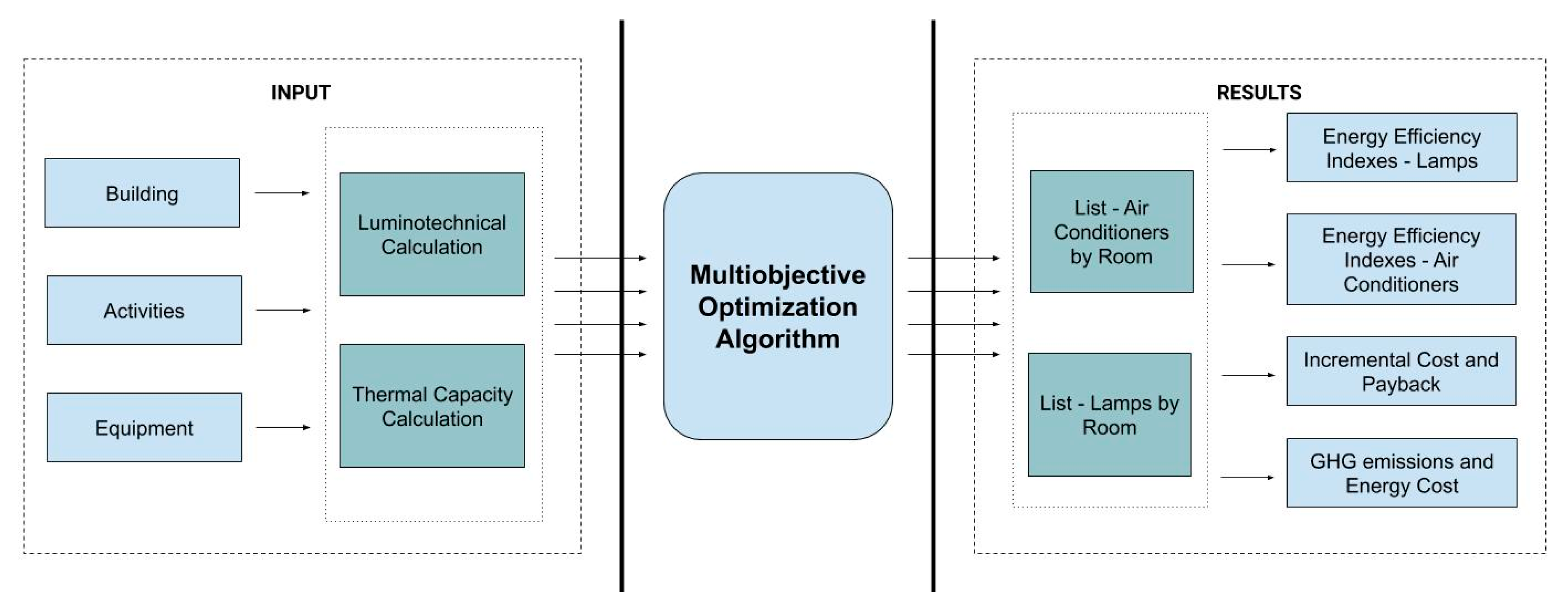
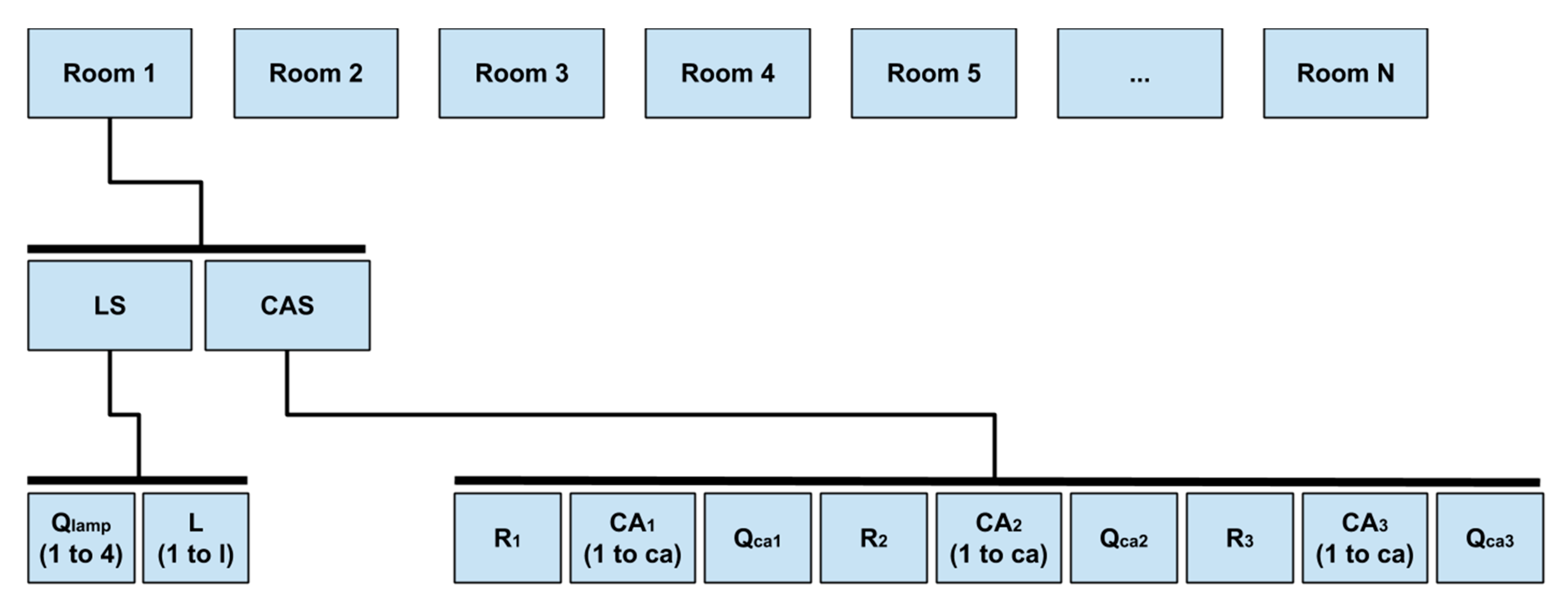


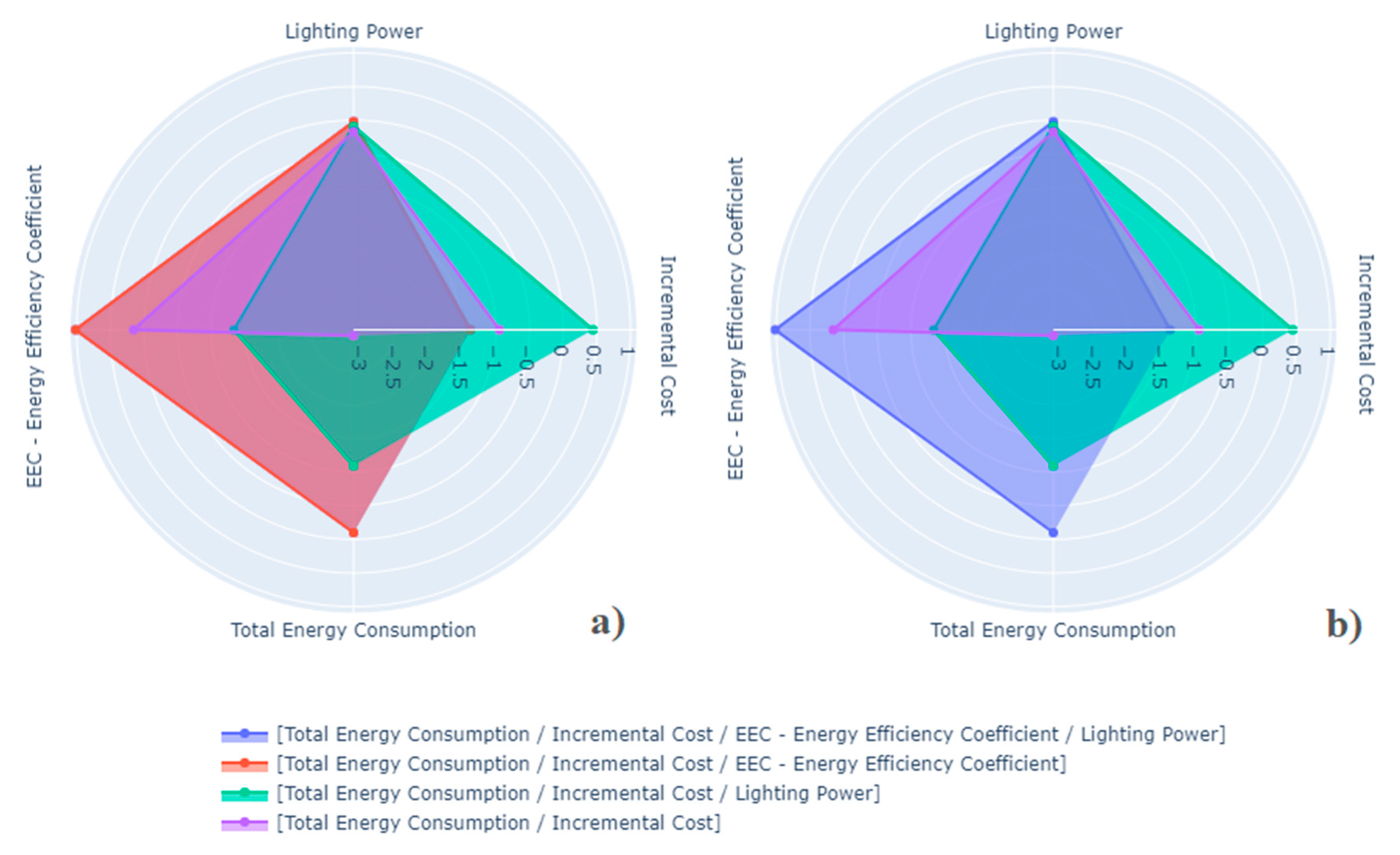
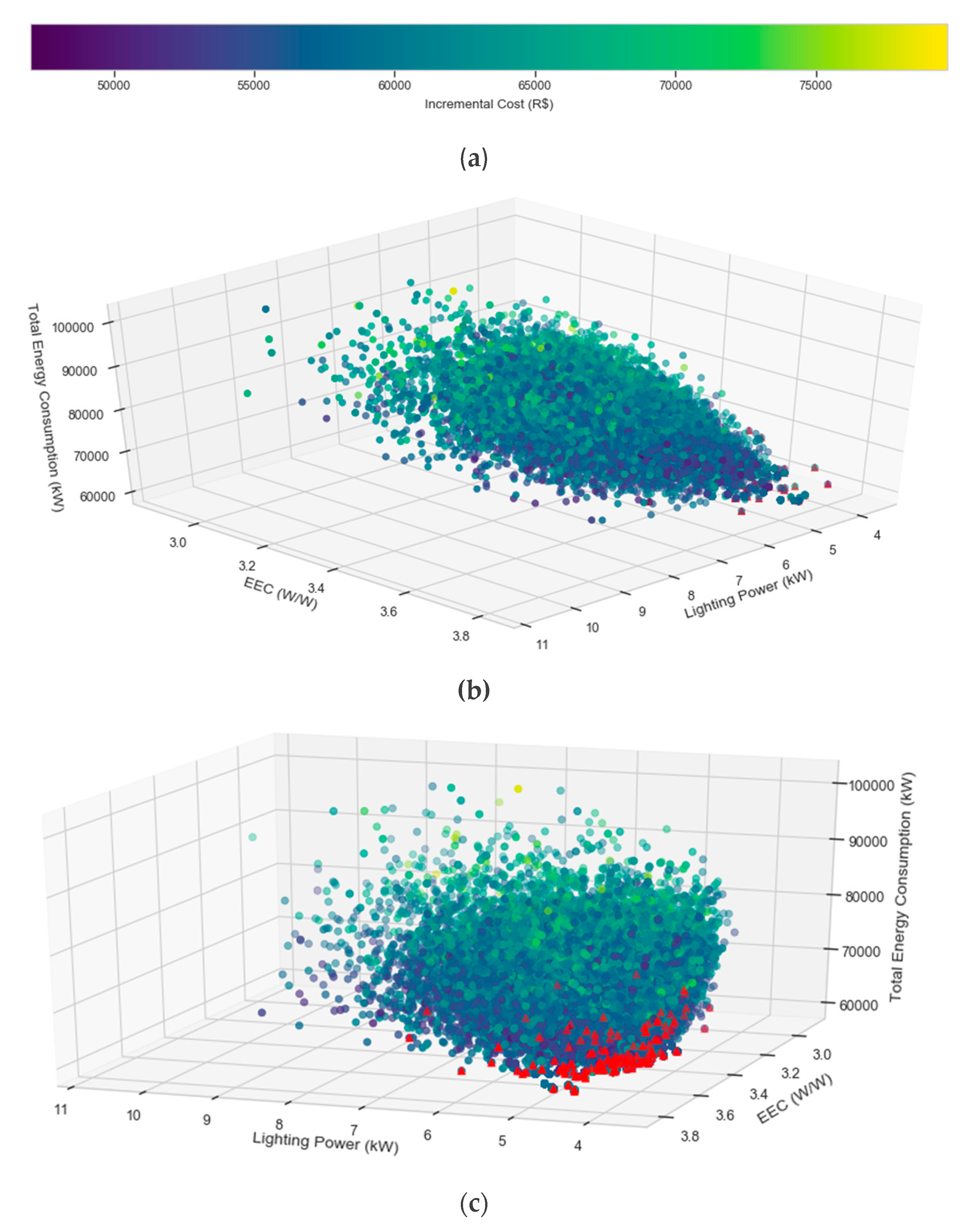

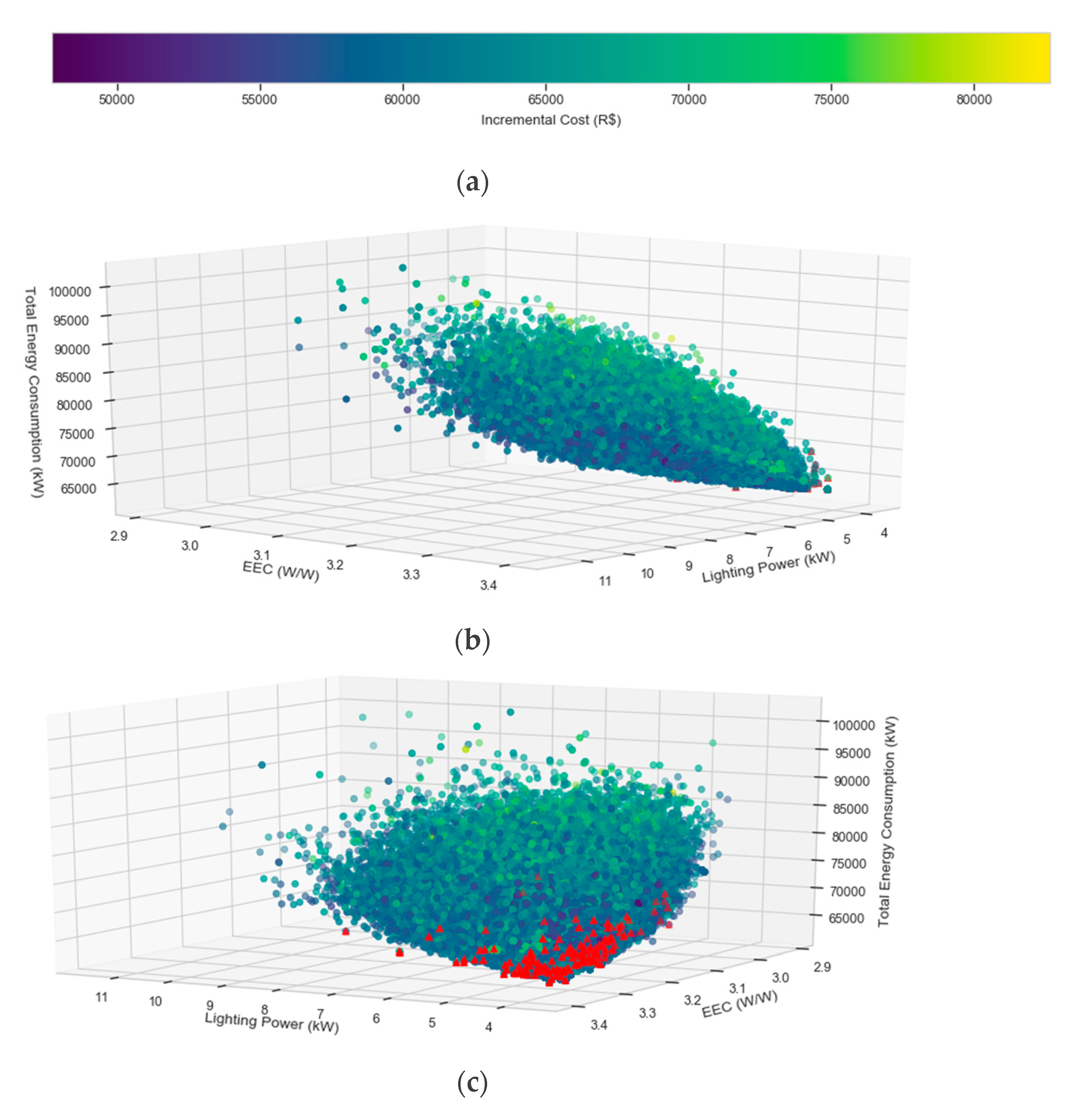
| Air Conditioning | Room; Range; Quantity; Type; Capacity (BTU/h); Power (W); Price (R$) |
| Lighting | Room; Luminaire/Room; Lamps/Luminaire; Lamps Total; Type; Power (W); Luminous flux; Price (R$) |
| Activities | Index; Building Function; DPL Class A (W/m2); DPL Class B (W/m2); DPL Class C (W/m2); DPL Class D (W/m2); Desired illuminance (LUX) |
| Building | Activity 1; Activity 2; Activity 3; Electricity Price; Utilization (h/d); Utilization (d/y); Length; Width; floor/ceiling height; Number of Floors; Wall Thickness; Geographical orientation of the main facade; Aperture 1, 2, 3 and 4 (%); Window: External protection; Window: Internal Protection; Common Glass; Slab ceiling; |
| Rooms | Index; Floor; Side; Function; Number of Users; Width; Length; Area. |
| Range | Cooling Capacity (kW) | Cooling Capacity (BTU/h) |
|---|---|---|
| 1 | 1.4653 kW to 2.3445 kW | 5000 to 8000 BTU/h |
| 2 | 2.4911 kW to 3.3703 kW | 8500 to 11,500 BTU/h |
| 3 | 3.5168 kW to 4.3960 kW | 12,000 to 15,000 BTU/h |
| 4 | 4.6891 kW to 6.1544 kW | 16,000 to 21,000 BTU/h |
| 5 | 6.4475 kW to 7.6198 kW | 22,000 to 26,000 BTU/h |
| 6 | 7.9129 kW to 9.3782 kW | 27,000 to 32,000 BTU/h |
| 7 | 9.6713 kW to 10.5505 kW | 33,000 to 36,000 BTU/h |
| 8 | 11.1367 kW to 12.3089 kW | 38,000 to 42,000 BTU/h |
| 9 | 12.6020 kW to 14.0674 kW | 43,000 to 48,000 BTU/h |
| 10 | 14.9466 kW to 15.8258 kW | 51,000 to 54,000 BTU/h |
| 11 | 16.1189 kW to 17.5842 kW | 55,000 to 60,000 BTU/h |
| Index | Type | Cooling Capacity (kW) | Cooling Capacity (BTU/h) | Range | Electric Power (W) | CEE (W/W) | Price (R$) |
|---|---|---|---|---|---|---|---|
| 23 | Window | 3.516 | 12,000 | 3 | 773 | 4.55 | 1482.90 |
| 64 | Ceiling-Suspended | 10.550 | 36,000 | 7 | 2320 | 4.55 | 2799.30 |
| Objective Function | Case 1 | Case 2 | Case 3 | Case 4 |
|---|---|---|---|---|
| Total Energy Consumption | 54,955.82 ± (1196.12) | 54,518.35 ± (481.82) | 56,110.74 ± (544.53) | 54,915.84 ± (694.27) |
| Incremental Cost | 56,433.48 ± (2641.31) | 57,378.26 ± (3107.55) | 55,617.34 ± (2158.74) | 55,776.44 ± (883.08) |
| Energy Efficiency Coefficient | 3.99 ± (0.10) | 4.02 ± (0.06) | 3.88 ± (0.08) | 4.00 ± (0.07) |
| Lighting Power | 4.13 ± (0.09) | 4.13 ± (0.09) | 4.11 ± (0.11) | 4.01 ± (0.17) |
| Generations Numbers | 3662.60 ± (1055.74) | 3776.60 ± (860.28) | 2502.75 ± (682.48) | 3,882.60 ± (1096.19) |
| Total Cooling Capacity (BTU/h) | 393,000.0 | 393,000.0 | 397,000.0 | 392,000.0 |
| Total Cooling Capacity (kW) | 115.1769 | 115.1769 | 116.3492 | 114.8838 |
| Number of Lamps | 253 | 253 | 257 | 275 |
| Experiment 1 | Model Value |
|---|---|
| Incremental Cost (R$) | 60,850.40 |
| Incremental Cost ($) | 11,561.57 |
| Total Energy Consumption (kWh/year) | 54,171.6 |
| Energy Consumption – Lighting (kWh/year) | 6941.76 |
| Energy Consumption—Air Conditioning (kWh/year) | 47,229.84 |
| Thermal Capacity | 393,000 |
| CEE Total (W/W) | 3.94 |
| Energy Efficiency Level (RTQ-C)—Air Conditioning System | A |
| Power—Lighting (kW) | 4.13 |
| Energy Efficiency Level (RTQ-C)—Lighting System | A |
| Energy Cost (R$/year) | 36,348.06 |
| Energy Cost ($/year) | 6906.13 |
| GHG Emissions (ton CO2/year) | 4425.81 |
| Objective Function | Case 1 | Case 2 | Case 3 | Case 4 |
|---|---|---|---|---|
| Total Energy Consumption | 62,959.01 ± (539.80) | 62,959.01 ± (539.80) | 65,640.96 ± (6088.02) | 62,729.52 ± (747.53) |
| Incremental Cost | 62,229.93 ± (2272.17) | 62,229.93 ± (2272.17) | 62,764.59 ± (1849.94) | 65,125.05 ± (3599.16) |
| Energy Efficiency Coefficient | 3.34 ± (0.04) | 3.34 ± (0.04) | 3.32 ± (0.07) | 3.37 ± (0.02) |
| Lighting Power | 3.97 ± (0.19) | 3.97 ± (0.19) | 4.15 ± (0.39) | 4.08 ± (0.10) |
| Generations Numbers | 2246.20 ± (674.09) | 2246.20 ± (674.09) | 2620.80 ± (1350.39) | 2721.40 ± (901.83) |
| Cooling Capacity (BTU/h) | 383,500.0 | 383,500.0 | 441,000.0 | 386,000.0 |
| Cooling Capacity (kW) | 112.3927 | 112.3927 | 129.2443 | 113.1254 |
| Number of Lamps | 253 | 253 | 257 | 275 |
| Lighting System | |||||||
|---|---|---|---|---|---|---|---|
| Room | Luminaire | Lamps | |||||
| Index | Lamps/Lum | Lum/Room | Type | Luminous Flux | Power (W) | Price (R$) | |
| 1 | 18 | 1 | LED Compact | 977 | 11 | 10.05 | |
| 2 | 10 | 1 | LED Tube | 1744 | 20 | 20.00 | |
| 3 | 5 | 2 | LED Tube | 1744 | 20 | 20.00 | |
| 4 | 15 | 1 | LED Tube | 1744 | 20 | 20.00 | |
| 5 | 9 | 3 | LED Compact | 977 | 11 | 11.00 | |
| 6 | 16 | 1 | LED Tube | 1096 | 15 | 35.00 | |
| 7 | 6 | 3 | LED Compact | 977 | 11 | 10.05 | |
| 8 | 15 | 1 | LED Tube | 1179 | 15 | 29.00 | |
| 9 | 15 | 1 | LED Tube | 1179 | 15 | 29.00 | |
| 10 | 6 | 2 | Compact Fluorescent | 1500 | 23 | 5.90 | |
| 11 | 6 | 3 | LED Compact | 977 | 11 | 11.00 | |
| 12 | 27 | 1 | LED Compact | 977 | 11 | 11.00 | |
| 13 | 19 | 1 | LED Tube | 1432 | 20 | 35.00 | |
| 14 | 27 | 1 | LED Compact | 977 | 11 | 10.05 | |
| 15 | 27 | 1 | LED Compact | 977 | 11 | 11.00 | |
| Air Conditioning System | |||||||
| Room | Range | Quantity | Type | Cooling Capacity in kW (and BTU/h) | Cooling Capacity /Room in kW (and BTU/h) | Power (W) | Price (R$) |
| 1 | 1 | 3 | Ductless Split | 2.6376 (9000) | 7.9129 (27,000) | 719 | 1965 |
| 2 | 0 | 1 | Ductless Split | 2.1980 (7500) | 5.7148 (19,500) | 691 | 1035 |
| 2 | 2 | 1 | Ductless Split | 3.5168 (12,000) | 1068 | 1799 | |
| 3 | 2 | 2 | Ductless Split | 3.5168 (12,000) | 7.0337 (24,000) | 1010 | 1291 |
| 4 | 4 | 1 | Ductless Split | 6.4475 (22,000) | 9.6713 (33,000) | 1989 | 1792 |
| 4 | 1 | 1 | Ceiling Cassette | 3.2237 (11,000) | 996 | 1300 | |
| 5 | 1 | 4 | Ductless Split | 2.6376 (9000) | 10.5505 (36,000) | 719 | 1965 |
| 6 | 0 | 3 | Ductless Split | 2.1980 (7500) | 6.5940 (22,500) | 691 | 1299 |
| 7 | 2 | 1 | Ductless Split | 3.5168 (12,000) | 5.7148 (19,500) | 1096 | 1499 |
| 7 | 0 | 1 | Ductless Split | 2.1980 (7500) | 691 | 1299 | |
| 8 | 2 | 2 | Ductless Split | 3.5168 (12,000) | 7.0337 (24,000) | 1010 | 1291 |
| 9 | 1 | 3 | Ductless Split | 2.6376 (9000) | 7.9129 (27,000) | 719 | 1965 |
| 10 | 0 | 1 | Ductless Split | 2.1980 (7500) | 4.3960 (15,000) | 678 | 1796 |
| 10 | 0 | 1 | Window | 2.1980 (7500) | 754 | 938 | |
| 11 | 2 | 2 | Ductless Split | 3.5168 (12,000) | 7.0337 (24,000) | 1075 | 1320 |
| 12 | 3 | 1 | Ductless Split | 5.2752 (18,000) | 8.7921 (30,000) | 1600 | 2545 |
| 12 | 2 | 1 | Ductless Split | 3.5168 (12,000) | 1010 | 1291 | |
| 13 | 5 | 1 | Ductless Split | 8.7921 (30,000) | 8.7921 (30,000) | 2690 | 3509 |
| 14 | 5 | 1 | Ductless Split | 8.2059 (28,000) | 8.2059 (28,000) | 2700 | 3000 |
| 15 | 2 | 2 | Ductless Split | 3.8099 (13,000) | 7.6198 (26,000) | 1118 | 1500 |
| Quantities Analyzed | Experiment 1 | Experiment 2 |
|---|---|---|
| Incremental Cost (R$) | 60,850.40 | 60,741.95 |
| Incremental Cost ($) | 11,561.57 | 11,540.97 |
| Total Energy Consumption (kWh/year) | 54,171.6 | 62,966.40 |
| Energy Consumption—Lighting (kWh/year) | 6941.76 | 6431.04 |
| Energy Consumption—Air Conditioning (kWh/year) | 47,229.84 | 56,535.36 |
| Cooling Capacity (BTU/h) | 393,000 | 385,500 |
| Cooling Capacity (kW) | 115.1769 | 112.9788 |
| CEE Total (W/W) | 3.94 | 3.31 |
| Energy Efficiency Level (RTQ-C)—Air Conditioning System | A | A |
| Power—Lighting (kW) | 4.13 | 3.82 |
| Energy Efficiency Level (RTQ-C)—Lighting System | A | A |
| Energy Cost (R$/year) | 36,348.06 | 42,249.19 |
| Energy Cost ($/year) | 6906.13 | 8027.34 |
| GHG Emissions (ton CO2/year) | 4425.81 | 5144.35 |
© 2020 by the authors. Licensee MDPI, Basel, Switzerland. This article is an open access article distributed under the terms and conditions of the Creative Commons Attribution (CC BY) license (http://creativecommons.org/licenses/by/4.0/).
Share and Cite
A. Monteiro, S.; Monteiro, F.P.; Tostes, M.E.L.; Carvalho, C.M. Methodology for Energy Efficiency on Lighting and Air Conditioning Systems in Buildings Using a Multi-Objective Optimization Algorithm. Energies 2020, 13, 3303. https://doi.org/10.3390/en13133303
A. Monteiro S, Monteiro FP, Tostes MEL, Carvalho CM. Methodology for Energy Efficiency on Lighting and Air Conditioning Systems in Buildings Using a Multi-Objective Optimization Algorithm. Energies. 2020; 13(13):3303. https://doi.org/10.3390/en13133303
Chicago/Turabian StyleA. Monteiro, Suzane, Flávia P. Monteiro, Maria E. L. Tostes, and Carminda M. Carvalho. 2020. "Methodology for Energy Efficiency on Lighting and Air Conditioning Systems in Buildings Using a Multi-Objective Optimization Algorithm" Energies 13, no. 13: 3303. https://doi.org/10.3390/en13133303
APA StyleA. Monteiro, S., Monteiro, F. P., Tostes, M. E. L., & Carvalho, C. M. (2020). Methodology for Energy Efficiency on Lighting and Air Conditioning Systems in Buildings Using a Multi-Objective Optimization Algorithm. Energies, 13(13), 3303. https://doi.org/10.3390/en13133303





